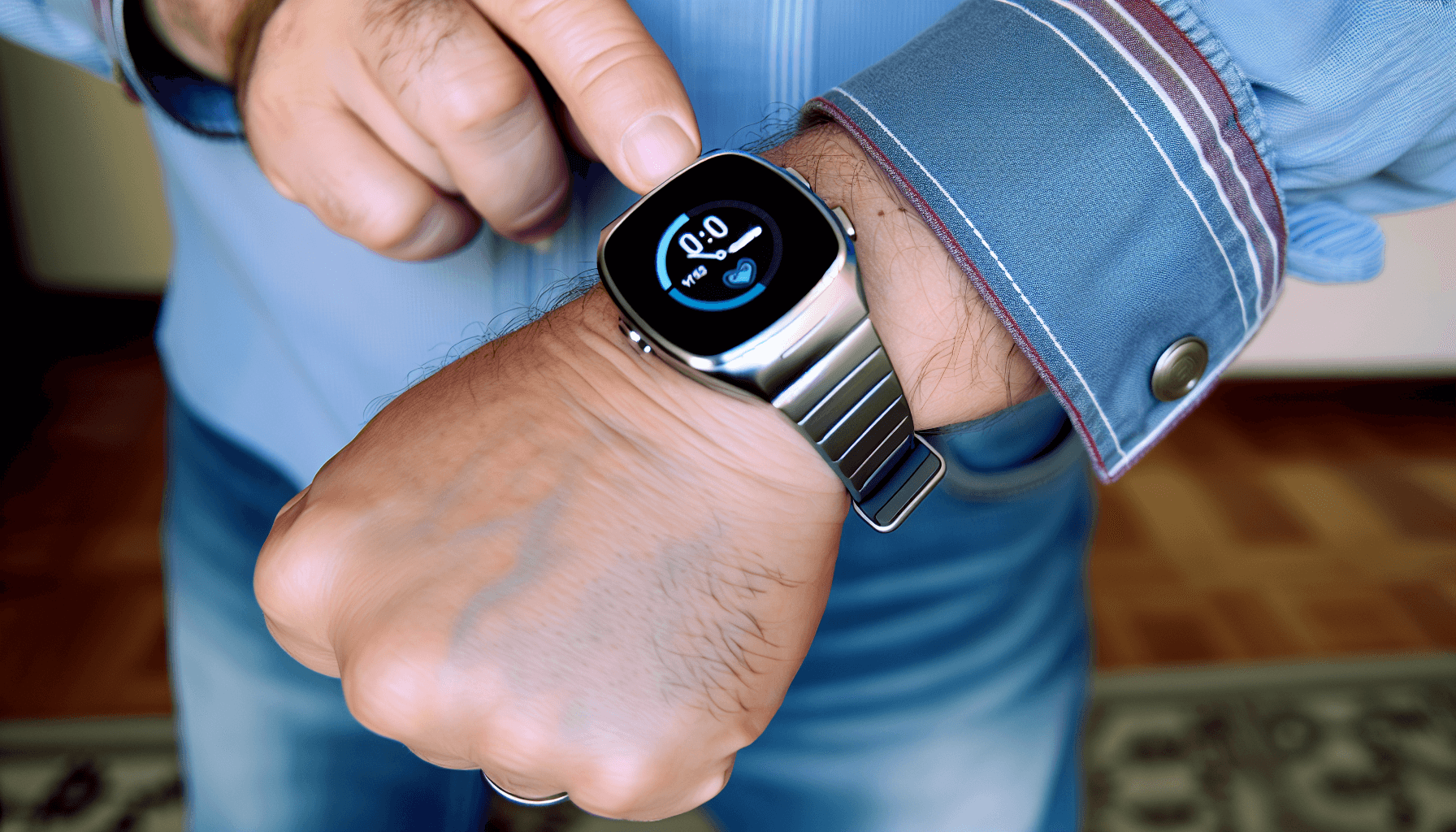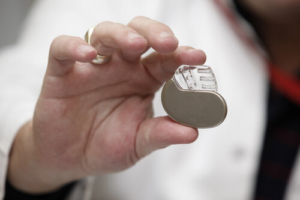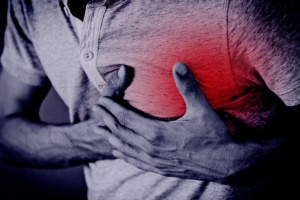How can I check for AFib at home? It’s possible. Quick and non-invasive methods, right from your home, can help alert you to atrial fibrillation. While home checks aren’t diagnostic tools, they can be crucial in recognizing early signs of AFib and fostering timely discussions with your doctor. Get ready to uncover the feasible ways to monitor your heart health at home.
Key Takeaways
AFib is the most common form of arrhythmia and can lead to severe complications including blood clots, stroke, heart failure, and other heart issues; it’s projected that 12.1 million Americans will be affected by AFib by 2030.
Individuals can monitor their heart rhythm at home using a manual pulse check and KardiaMobile devices, while smartwatches and fitness trackers with ECG technology provide an innovative method for detecting AFib.
Despite the availability of at-home monitoring methods, professional diagnosis of abnormal heart rhythms often requires a medical-grade ECG in a healthcare setting; lifestyle factors such as diet and stress directly impact heart rhythm health and should be managed appropriately.
Understanding AFib and Its Symptoms

Atrial fibrillation, or AFib as it is commonly known, is the most prevalent form of heart arrhythmia. This condition is characterized by irregular contractions of the upper heart chambers, which can affect blood vessels and blood flow, and significantly increases risk for stroke. Symptoms of AFib may encompass a sensation of skipped or added heartbeats, or a ‘fluttering’ sensation. In some cases, individuals may have more subtle symptoms such as fatigue or shortness of breath, and some patients may not experience any noticeable symptoms.
AFib has the potential to lead to serious complications, such as:
blood clots
stroke
heart failure
In fact, AFib is a significant health concern, with over 450,000 hospitalizations attributed to it as the primary diagnosis annually in the United States, leading to approximately 158,000 deaths each year. It is projected that by 2030, the number of individuals in the U.S. affected by AFib will reach 12.1 million.
So, suspecting AFib or experiencing irregular heartbeats, warrants scheduling a doctor’s appointment, as these symptoms could potentially lead to sudden cardiac arrest.
At-Home Monitoring Techniques for Detecting AFib

At-home monitoring techniques empower individuals to proactively detect early signs of AFib, contributing to their heart health. Several options are available for at home monitoring, including manual pulse checks, KardiaMobile devices, and smart watches.
Manual Pulse Check
A manual pulse check is a simple to monitor your heart rhythm. You can locate your pulse on your wrist or neck, and then monitor it for approximately 30 seconds. If your pulse feels regular or irregular, it could indicate the presence of AFib. A normal pulse is characterized by its steady and regular rhythm at rest, whereas an irregular pulse may feel uneven or erratic, often described as ‘jumping about’.
Be aware that AFib may cause a pulse rate exceeding 100 beats per minute, exceeding the typical adult resting heart rate of 60 to 100 beats per minute. This irregular heart rhythm can occasionally lead to symptoms such as palpitations, shortness of breath, or chest pain.
With that said, a manual pulse check is the least accurate method for checking for AFib, compared to the other options listed below.
KardiaMobile Devices for AFib Monitoring
KardiaMobile by AliveCor is a popular product in the field of at-home heart monitoring. The company offers two variants: the original KardiaMobile Single Lead and KardiaMobile 6L.
KardiaMobile Single Lead
The KardiaMobile Single Lead is a compact, portable ECG device that connects to your smartphone via Bluetooth. It allows you to capture a medical-grade ECG in just 30 seconds. The device is capable of detecting AFib, Bradycardia, Tachycardia, and Normal Sinus Rhythm, making it a versatile tool for heart rhythm monitoring.
In terms of accuracy, the KardiaMobile Single Lead has demonstrated a sensitivity of 93.6% and a specificity of 84.3% in detecting AFib. This makes it a reliable tool for initial heart rhythm screening. The device is usually with list price at around $99, making it an affordable option for at-home monitoring.
KardiaMobile 6L
The KardiaMobile 6L is the first and only FDA-cleared six-lead personal ECG. It captures six leads of heart data (Lead I, II, III, aVL, aVR, and aVF) for a more detailed view of your heart. This device is particularly useful for detecting and monitoring AFib, as well as other forms of cardiac arrhythmia.
The KardiaMobile 6L has demonstrated a sensitivity of 98% and a specificity of 97% in detecting AFib, which is significantly higher than any single lead device. However, this increased accuracy comes at a higher price point, with the device retailing list price of approximately $149.
Cardiologists’ Most Recommended Product for at home AFib Monitoring
Many cardiologists recommend the use of KardiaMobile devices for at-home heart monitoring, particularly for patients with AFib. The devices’ high accuracy rates, ease of use, and affordability make them an excellent choice for initial heart rhythm screening and monitoring.
However, it’s important to remember that these devices should complement, not replace, regular check-ups with a healthcare professional.
Wearable Technology for AFib Detection

Advancements in technology have also brought wearable devices like smartwatches and fitness trackers to the forefront, providing an innovative method for detecting AFib.
Smartwatch Innovations
Using ECG technology, smartwatches are now able to gauge blood flow and the heart’s electrical signals, thereby assisting in the detection of AFib, as well as providing alerts for an irregular heart rhythm. Smartwatches equipped with ECG monitoring capability are specifically designed to contribute to AFib detection. They have demonstrated a sensitivity and specificity ranging from 70% to 90% in detecting AFib, proving to be a reliable tool for heart monitoring.
Apple Watch for AFib Detection
Apple Watch has emerged as a popular tool for heart rhythm monitoring, thanks to its built-in ECG technology. The Apple Watch Series 4 and later models are equipped with an ECG app that can detect irregular heart rhythms suggestive of AFib.
When the user feels an irregular heart rhythm, they can activate the ECG app to record their heart’s electrical signals. The watch then generates an ECG waveform in about 30 seconds. The waveform can show whether the heart rhythm indicates AFib or a normal sinus rhythm.
The Apple Watch also features an irregular rhythm notification feature. The watch also uses a method known as photoplethysmography to analyze pulse rate data. If the watch detects an irregular rhythm that appears to be AFib, it sends a notification to the user.
It’s important to note that while the Apple Watch can provide useful data, it does not replace a traditional ECG and should not be used as a diagnostic tool. It is a consumer device designed to provide helpful health-related information and encourage a conversation with your healthcare provider.
The Apple Watch Series 4 was the trailblazer in being able to detect an irregular heart rhythm on a wearable device. With the advancements in technology, smartwatches have now become a common tool in monitoring heart health, offering a convenient and user-friendly way to keep track of your heart rhythm.
Fitbit Models with ECG for AFib Monitoring
Fitbit, a well-known brand in the world of fitness trackers, has also joined the race in providing ECG technology for AFib detection. The Fitbit Sense, for instance, is equipped with an ECG app that allows users to check their heart rhythm for signs of AFib.
The Fitbit Sense works by having the user place their fingers on the corners of the stainless steel ring around the watch while being still for 30 seconds. The ECG app then assesses the user’s heart rhythm for signs of AFib and provides a reading that can be shared with healthcare providers.
The Fitbit Sense also features an irregular rhythm notification feature. If the device detects an irregular rhythm that appears to be AFib, it sends a notification to the user.
It’s important to remember that while the Fitbit Sense can provide valuable data, it does not replace a traditional ECG machine and should not be used as a diagnostic tool. It is a consumer device designed to provide helpful health-related information and encourage a conversation with your healthcare provider.
When to Use a Medical-Grade ECG or Cardiac Monitor
While home monitoring techniques offer valuable heart health insights, certain instances necessitate a medical-grade heart monitor. To diagnose an abnormal heart rhythm, a clinical or medical-grade electrocardiogram (ECG or EKG) is typically used. This test helps healthcare providers understand the nature of the heart’s electrical activity. To evaluate the heart rate and rhythm, sensors or electrodes are attached to the chest and various limb. ECGs are commonly performed in medical facilities such as doctor’s offices, clinics, or hospitals.
A heart monitor patch is an adhesive placed on the chest area to monitor and record heart activity. These patches are an integral part of the standard ECG procedure in medical settings. In some cases, a holter monitor or a cardiac event monitor may be used for long-term monitoring of infrequent symptoms in heart patients, with prolonged monitoring for several days or weeks as needed.
Recognizing False Positives and Negatives
As with any technology, at-home monitoring methods are not perfect and can sometimes yield false positives or negatives. Factors like noise, other arrhythmias, frequent ectopy, and oversensing can lead to incorrect positive results. Meanwhile, false negatives occur with a prevalence of approximately 33.3%, due to factors like misinterpretation of ECGs, patient characteristics, and the presence of other heart rhythm abnormalities.
Nevertheless, technological advancements, including advanced processing of photoplethysmographic (PPG) and accelerometer recordings, have diminished the effect of motion artifacts on AFib detection. Despite the potential for false positives and negatives, consulting with healthcare professionals is essential to ensure an accurate diagnosis of AFib.
Lifestyle Factors That Influence Heart Rhythm

Your lifestyle significantly influences your heart’s rhythm health. Factors such as diet and stress can significantly influence your heart rhythm, making it crucial to maintain a balanced diet and manage stress effectively.
The Role of a Healthy Diet
A healthy diet is one of the key factors in maintaining a healthy heart rhythm. Diets that are rich in:
have the potential to contribute to heart rhythm disorders like AFib. On the other hand, consuming foods rich in omega-3 fatty acids, like fatty fish, can reduce the likelihood of irregular heartbeat.
It’s also important to monitor your sodium and cholesterol intake. The American Heart Association suggests that individuals with AFib should limit their daily sodium intake to no more than 2,300 milligrams, with an ideal limit of 1,500 mg to promote a healthy heart rhythm. Furthermore, diets high in saturated and trans fats, commonly found in high cholesterol foods, may elevate the risk of AFib and heart rhythm irregularities.
Importance of Managing Stress
Stress is another significant factor that can affect your heart rhythm. Chronic stress and an anxious state can promote AFib through various mechanisms that act at different levels to trigger and modulate heart rhythm. This makes stress management a crucial part of AFib management.
Stress management techniques that can help in decreasing AF episodes and enhancing the overall quality of life for individuals with AFib include:
Yoga
Regular exercise
Maintaining a healthy diet
Ensuring adequate sleep
Practicing relaxation techniques
Mindfulness and meditation
These techniques have been shown to mitigate stress and negative emotions, potentially leading to a decrease in the frequency of AF episodes and an improvement in the overall quality of life for individuals with AFib.
Natural AFib Treatment at Home with the Take Control Over AFib Program
The Take Control Over AFib Program offers an evidence-based plan to manage atrial fibrillation naturally at home. The program is a cost-effective solution that includes over 20 video lessons covering comprehensive information on diet, stress, exercise, medications, and procedures, a 28-day Reverse AFib meal plan, and a complimentary eBook copy of Your Complete Guide To AFib.
This tailored approach, based on clinical trials and research, addresses inflammation, a key factor in AFib, and empowers you to prevent unexpected AFib episodes, reduce reliance on medications, ER visits, and high medical costs associated with uncontrolled atrial fibrillation. Start your journey towards better health today with this go-at-your-own-pace program and take back control of your life from AFib.
Learn more about the Take Control Over AFib Program here.
Documenting Your Findings for Your Doctor
Home heart rhythm monitoring is just one part of the process. The other part is accurately recording your findings and communicating them to your healthcare provider. Using an ECG device like KardiaMobile can help you identify dysrhythmias, including AFib.
Alongside ECG recordings, manually checking your pulse and noting any symptoms experienced at the time can assist in a proper diagnosis. Documenting AFib symptoms should include palpitations, dyspnea (shortness of breath), chest pain, and any pulse or jugular venous pulsation irregularities.
Risk Factors and Prevention Strategies
Specific risk factors can elevate your chances of developing AFib. Some of these risk factors include:
Advancing age
High blood pressure
Individuals of European descent (more susceptible compared to African-Americans)
Obesity
Hypertension
Diabetes mellitus
Physical inactivity
These factors all contribute to the likelihood of developing atrial fibrillation.
AFib prevention entails managing these common risk factors. This includes:
maintaining a healthy weight
managing high blood pressure
controlling cholesterol levels
reducing alcohol intake
quitting smoking
maintaining a heart-healthy diet
Regular exercise and stress management techniques are also beneficial in managing and preventing AFib.
Summary
In conclusion, monitoring your heart rhythm is an essential aspect of heart health, particularly in detecting and managing AFib. While at-home monitoring methods like manual pulse checks, KardiaMobile devices, and wearable technology offer convenient and effective ways to track heart rhythm, they should not replace professional medical advice. Alongside these methods, maintaining a healthy lifestyle through balanced diet and stress management plays a critical role in managing and preventing AFib.
Frequently Asked Questions
Can AFib be detected at home?
Yes, at-home monitors can be very helpful for the early detection of Atrial Fibrillation (AFib) and can connect people to medical professionals faster.
Can you tell if you are in AFib by checking your pulse?
Yes, you can check if you are in AFib by measuring your heart rate through your pulse. A normal resting heart rate should range from 60 to 100 beats per minute, while in atrial fibrillation, it could be over 100 beats per minute and feel irregular, not steady.
How do doctors confirm AFib?
Doctors confirm AFib through an Electrocardiogram (EKG), which involves placing small electrodes on your chest, arms, and legs to monitor your heart’s electrical activity at rest or during exercise. Prolonged cardiac monitors such as Holter monitors or extended telemetry monitoring is also commonly used to confirm AFIb.
What is Atrial Fibrillation (AFib) and what are its symptoms?
Atrial Fibrillation (AFib) is the most prevalent form of arrhythmia, characterized by irregular contractions of the upper heart chambers. Its symptoms may include a sensation of skipped or added heartbeats, or a ‘fluttering’ sensation.
The Best Atrial Fibrillation Book
Your Complete Guide To AFib: The Essential Manual For Every Patient With Atrial Fibrillation

Shop AFib Products on Amazon
KardiaMobile 6-Lead Personal EKG Monitor – Six Views of The Heart – Detects AFib and Irregular Arrhythmias – Instant Results in 30 Seconds – Works with Most Smartphones - FSA/HSA Eligible

KardiaMobile 1-Lead Personal EKG Monitor – Record EKGs at Home – Detects AFib and Irregular Arrhythmias – Instant Results in 30 Seconds – Easy to Use – Works with Most Smartphones - FSA/HSA Eligible

Apple Watch Series 9 [GPS 41mm] Smartwatch with Storm Blue Aluminum Case with Silver Sport Band M/L. Fitness Tracker, Blood Oxygen & ECG Apps, Always-On Retina Display

Fitbit Sense 2 Advanced Health and Fitness Smartwatch with Tools to Manage Stress and Sleep, ECG App, SpO2, 24/7 Heart Rate and GPS, Shadow Grey/Graphite, One Size (S & L Bands Included)

OMRON - Complete Wireless Upper Arm Blood Pressure Monitor + EKG - Built-in Bluetooth Technology
38% Off
Omron Hem 7361T Bluetooth Digital Blood Pressure Monitor with Afib Indicator and 360° Accuracy Intelliwrap Cuff for Most Accurate Measurements (White)

EMAY Portable ECG Monitor | Record ECG and Heart Rate Anytime Anywhere | Stand-Alone Device with LCD Screen and Storage | No Subscription Required

SAMSUNG Galaxy Watch 6 44mm Bluetooth Smartwatch, Fitness Tracker, Personalized HR Zones, Advanced Sleep Coaching, Heart Monitor, BIA Sensor, Health Wellness Insights, Big Screen, US Version, Graphite

Natural Rhythm Triple Calm Magnesium 150 mg - 120 Capsules – Magnesium Complex Compound Supplement with Magnesium Glycinate, Malate, and Taurate. Calming Blend for Promoting Rest and Relaxation.

Pure Encapsulations Magnesium (Glycinate) - Supplement to Support Stress Relief, Sleep, Heart Health, Nerves, Muscles, and Metabolism* - with Magnesium Glycinate - 180 Capsules


















![Apple Watch Series 9 [GPS 41mm] Smartwatch with Storm Blue Aluminum Case with Silver Sport Band M/L. Fitness Tracker, Blood Oxygen & ECG Apps, Always-On Retina Display #1](https://m.media-amazon.com/images/I/311xwtp4mFL._SL100_.jpg)
![Apple Watch Series 9 [GPS 41mm] Smartwatch with Storm Blue Aluminum Case with Silver Sport Band M/L. Fitness Tracker, Blood Oxygen & ECG Apps, Always-On Retina Display #2](https://m.media-amazon.com/images/I/41j+8AaUGsL._SL100_.jpg)
![Apple Watch Series 9 [GPS 41mm] Smartwatch with Storm Blue Aluminum Case with Silver Sport Band M/L. Fitness Tracker, Blood Oxygen & ECG Apps, Always-On Retina Display #3](https://m.media-amazon.com/images/I/41jIyxZitnL._SL100_.jpg)
![Apple Watch Series 9 [GPS 41mm] Smartwatch with Storm Blue Aluminum Case with Silver Sport Band M/L. Fitness Tracker, Blood Oxygen & ECG Apps, Always-On Retina Display #4](https://m.media-amazon.com/images/I/41IpNJERjCL._SL100_.jpg)
![Apple Watch Series 9 [GPS 41mm] Smartwatch with Storm Blue Aluminum Case with Silver Sport Band M/L. Fitness Tracker, Blood Oxygen & ECG Apps, Always-On Retina Display #5](https://m.media-amazon.com/images/I/31o17yhfYpL._SL100_.jpg)

















































